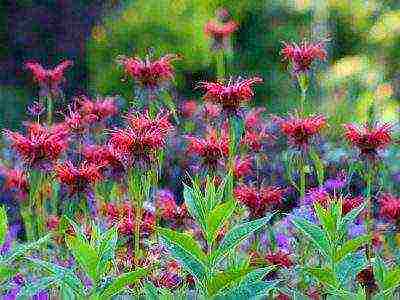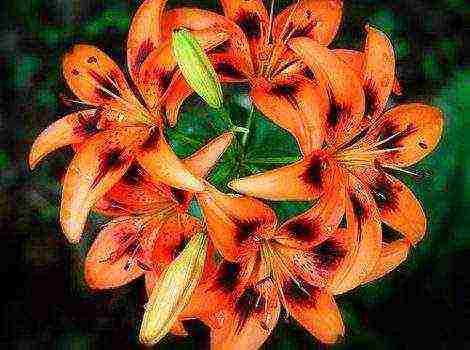Content
- 1 General information about the lemon Monarda plant
- 2 Cultivation and care of lemon monarda
- 3 Properties of lemon monarda
- 4 see also
- 5 Monarda varieties and types
- 6 Monarda planting and care in the open field
- 7 Soil for monarda
- 8 Fertilizer for monarda
- 9 Monarda in winter
- 10 Monarda growing from seeds
- 11 Monarda reproduction by dividing the bush
- 12 Diseases and pests
- 13 Monarda medicinal properties and contraindications
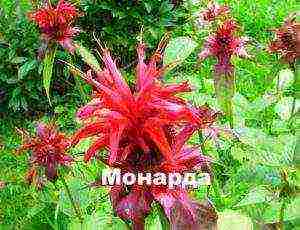 Monarda lemon is an ornamental plant, looks beautiful in photographs, in the country, can be used for bouquets, but it is popular not only because of this.
Monarda lemon is an ornamental plant, looks beautiful in photographs, in the country, can be used for bouquets, but it is popular not only because of this.
Lemon monarda contains honey nectar, there are essential oils in the inflorescences and leaves.
To obtain essential oils, the leaves must be harvested when the plant is in bloom.
At the same time, the plant is most active for the first five years, then the effectiveness of the oils decreases.
General information about the lemon Monarda plant
Origin
The monard plant has several types, these are:
- double monard,
- fisty,
- lemon monard.
Belongs to a fast-growing perennial herb, but is more often grown as an annual plant, to the family of lamb, labiate.
They grow in North America and Mexico. Monarda is sometimes called bergamot, they are similar.
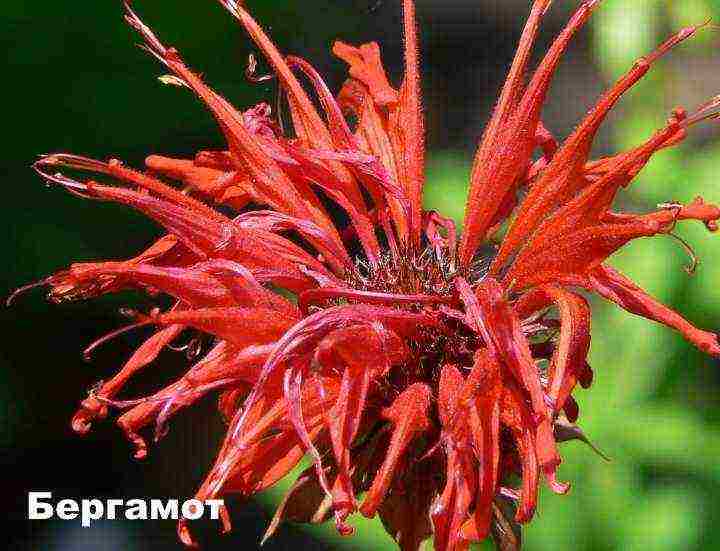
The herb lemon monarda is used in medicine and cooking, as it has a pleasant aroma. If you grind the leaves of lemon monarda, a lemon-like aroma is released. Some say that rubbing old monarda leaves smells like oregano.
Sprouting
The plant was named after the botanist from Spain who first described it, Nicholas Monardes. In Russia, in its middle lane, the most famous varieties of lemon monarda are such varieties as Mona Lisa, Diana, Solntsevsky semko.
Usually these are annual plants, sometimes they tolerate the winter quite well. In Russia, the Monarda variety Mona Lisa is available for use.
Appearance
Outwardly, it is a bush, from the center of which stems grow.
Since the lemon monard is an ornamental plant with useful properties, it is actively spreading throughout Europe.

In a simple way, lemon monard is called bergamot, lemon mint, American lemon balm. The plant has a spicy smell, enriched with essential oils.
Monarda lemon has a fairly strong aroma, which is similar to the smell of mint and lemon.
Monarda lemon is a bush with stems, with green oval leaves with a sharp tip 4-8 centimeters long. Stems are thin, around them curled flowers are white, pink, purple.
 The lemon monard can reach a height of one meter, the stem height is usually 80 centimeters.
The lemon monard can reach a height of one meter, the stem height is usually 80 centimeters.
The stem is a branched, tetrahedral shoot that grows upright. The plant has oval oblong, serrated leaves.
The flowers of lemon monarda can be of different colors, red, purple, white, together they form inflorescences, their diameter is usually seven centimeters.
On the stem of the plant, the flowers are located one above the other. The citrus scent of monarda attracts bees and butterflies.
Monarda lemon belongs to the mint family, sometimes it is called American lemon balm, bergamot.
In addition to decorative functions, lemon monarda also has medicinal properties.
The plant has an antimicrobial, anthelmintic effect on the body due to the content of essential oils with vitamins C, B1, B2 in the stems.
Cultivation and care of lemon monarda
Soil requirements
For lemon monarda, clay soil is more suitable, but the area should be without the risk of flooding.
In this case, the monard can survive drought, grow in calcareous or alkaline soil.
It grows naturally in a limestone wasteland. The most suitable place for a monarda would be a sunny place.
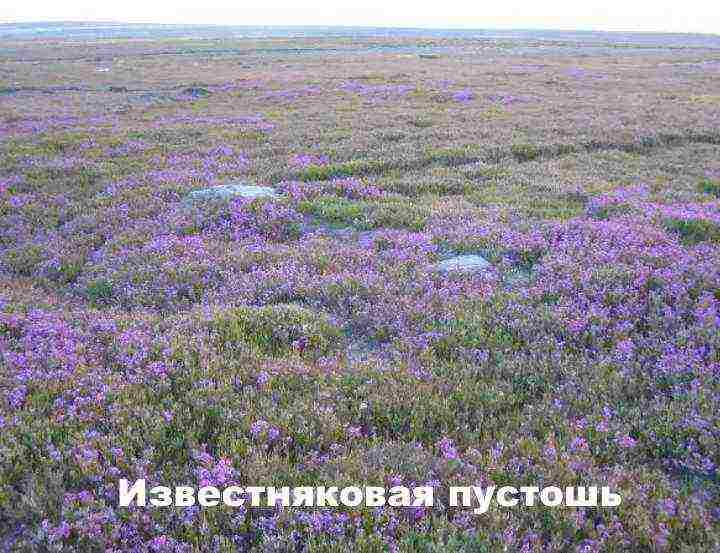
Most of the monarda varieties are perennials. With the onset of winter, the upper aboveground part of the plant withers, and closer to spring, the flower awakens. It blooms for two months in summer from July.
Reproduction
Lemon monarda begins to grow by planting seedlings. You can use the option of dividing the bush, or growing from seeds.
Seedling method
To prepare seedlings, you need to sow seeds in boxes in January or February. After three weeks, shoots may already appear. To germinate seeds, you need a temperature of at least 20 degrees.

They can be planted on the site in two - two and a half months, and you can not be afraid of frost. You can choose either a sunny or semi-dark place.
The depth of the soil should be about two centimeters, the soil must first be loosened and manure, minerals, sand, lime should be added. And in the process of the transplant itself, you also need to add ammonium nitrate.
Bush dividing method
You can use the method of dividing the bushes, but the bush must be 4 years old. From one bush, you can make up to 28 seedlings, but this does not apply to all varieties of monarda, but not for lemon.
For lemon monarda, planting seedlings is more suitable. The first two months, the bush will grow slowly, gradually increasing growth. During the summer, you can do weeding from weeds 3 times.
Properties of lemon monarda
Monarda lemon is appreciated for its essential oils, they are used in perfumery, for medicinal purposes. The essential oil of lemon monarda is called citronella and contains phenolic monoterpenes, thymol.

Has pronounced antioxidant and bactericidal properties. The essential oil is used in the treatment of coughs, colds, and fevers. It can also be used to get rid of intestinal parasites, to scare off fleas, ticks.
Monarda can also be used to flavor tea, as a seasoning for meat dishes.
Lemon monarda can also be used as a medicine:
- for the treatment of asthma, bronchitis,
- as an antimicrobial agent,
- to get rid of helminths, salmonella,
- for skin healing from burns.
Lemon monarda is used in cooking:
- to give a lemon flavor to some dishes, in particular desserts, cheesecakes, cookies, cakes,
- for fish dishes, salads, sauces.
- to decorate garnishes, since flowers are considered edible,
- and pieces of leaves can be frozen with ice cubes and added to drinks (watch the video).
TOP proven suburban shops in the Russian Federation - Choose, buy!
- - "Garden and Vegetable Garden" - Gardens of Russia is an online store of seeds and seedlings.
- - "Becker" is a popular store of seedlings, seeds, bulbs, delivery all over Russia!

If you want to get a very unusual plant that can be used as a spice, then start growing lemon monarda from seeds. We will tell you how to do this in this article.
Meet Monarda
This perennial plant, which we grow as an annual, came to us from the USA. Its leaves and stem can smell of different essential oils: mint, lemon, citrus and even bergamot. We use it as an ornamental and medicinal plant, and besides that, it is an excellent source of nectar for the shoulders and a means of protection against some pests.
Monarda is a tall (80-100 cm) well-branching plant, the stems of which are crowned with single or one-on-one inflorescences of two-lipped flowers. The color of the inflorescences can be different, depending on the species. Flowering begins in mid-summer (July) and lasts almost 2 months.
Growing lemon monarda
If you want to grow a monarda with a lemon aroma, then you will have to choose between the Mona Lisa and Solntsevsky Semko varieties. They both have pale purple inflorescences.
In order for your lemon monard to bloom more abundantly, then it must be planted in a sunny place, if longer, then in partial shade. It is not particularly whimsical to the quality of the soil; it grows poorly only on acidic and waterlogged ones. The selected area should be dug up twice (in autumn and spring), applying fertilizers both times.
In the southern regions, sowing can be carried out directly into the ground, after the weather is good and the soil warms up. In cooler climates, it is recommended to first grow the seedlings by sowing them in February. With the second method of growing lemon monard, it will turn out to be stronger.
Seedlings are planted in open ground when 2 pairs of real leaves grow in it. A distance of at least 35 cm should be retreated between the holes. Immediately after planting, the soil must be moistened and loosened.
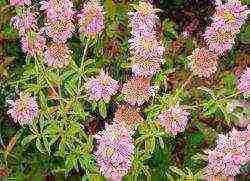
In the future, caring for the monarda will consist in carrying out 2-3 loosening of the soil around them during the season, making additional fertilizing, watering and controlling weeds. It should be watered as the soil dries up; in hot summer conditions, the ground around it should be covered with peat, or it will be necessary to water it more often. For the formation of a large number of stems, during the period of active growth, the application of mineral and organic fertilizers should be alternated.
If you want to make an essential oil from this flower, then it is necessary to cut off the ground part during the period when the monarda massively blooms. You can take flower stalks for making bouquets at any time, as well as collecting leaves for making tea.
Only a few have the opportunity to plant lemon in their garden, but you can grow lemon monarda even in the northern regions. And what is it, in fact, worse than lemon? The aroma is citrus, lemon tea is brewed from it, it is used in cooking.
Once passing by flower stalls that sell seeds, I saw a new plant. It was a monarda, but not simple, but lemon - her flowers are completely different. I looked at this bag and bought it.
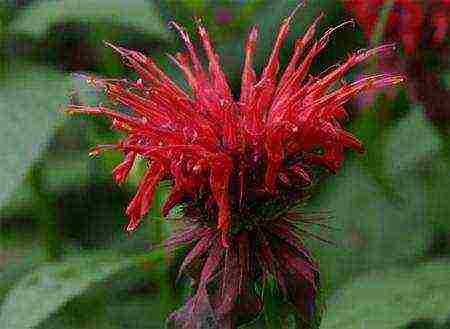
I sowed seeds for seedlings in March in ordinary purchased land to a depth of 1-1.5 cm and covered it with a film, at times opened it for airing. The seeds sprouted together, and the seedlings looked like soldiers in the ranks. At first, the seedlings grew slowly, and then quickly began to gain strength. I planted it in the open ground at the end of April, because the monarda seedlings can withstand frosts down to -3.5?, And I put a mini-greenhouse on top. In May, when it finally got warmer, I removed the greenhouse, and the plants started growing very quickly. I put them on a permanent place at a distance of 20 cm from each other. The lemon monard grows up to 70 cm in height, so I planted it with phlox, chamomile and echinacea.
Since there were a lot of seedlings, I planted them everywhere: both in the sun and in partial shade under the trees. And I noticed that in a sunny place the monard grows in breadth, and blooms longer and brighter in partial shade. I planted the last seedlings in rows with tomatoes, and the fruits of the tomatoes grew strong and very tasty.
Lemon monarda blooms from June until frost very abundantly. Lilac flowers are collected in inflorescences of 5-6 tiers. Chandelier-like, the leaves are silvery-gray with a metallic sheen. During flowering, the monarda envelops the garden with a pleasant lemon scent.
My lemon monarda bloomed in the first year. It reproduces by dividing the bush, green cuttings. Cutting in water costs up to two weeks and does not lose its appearance and aroma.
For the winter, I cut the monarda at the root and covered it with dry leaves. In spring it grows very early - at the end of March.
I use young leaves for tea and add to spring salads.
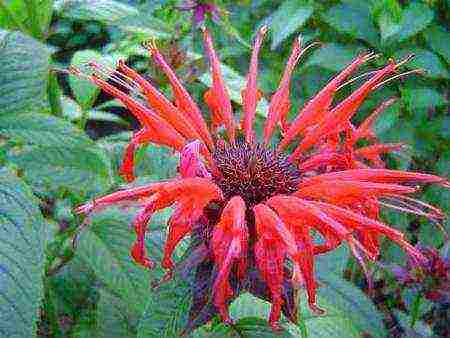
For the winter, I harvest raw materials in the flowering phase - the leaves are very tender at this time. I store it in a tightly sealed container until the next harvest.
I also use Monarda in cooking: I put a branch of a plant along with leaves and flowers in a jar when salting cucumbers. She gives a special aroma to apple jam, compotes, jelly. A very tasty tea is obtained if you take 3 tsp for 1 liter of boiling water. black tea (no flavors), 3 tsp. dried leaves and inflorescences of monarda and 50 g of sugar.
Here it is - lemon monarda! Plant her in your garden.
Based on materials from the magazine "I Love Flowers"
see also
| Monarda planting and care in the open field
Monarda is used as a medicinal and gingerbread plant. Young leaves of lemon monarda are added to salads and tea. A decoction of the leaves and flowers of the tubular monarda is used as a medicinal and tonic tea. |
Monarda is a member of the Lipoceae family, which got its name in honor of the botanist and physician from Spain, Nicholas Monardes. This Spanish scientist first described the monarda plant and told about it to Europeans in his books "Medical History of Western India" and "Good News from the New World", calling it a Virginian soulmate or Canadian Origan.
Monarda's lemon scent has many virtues. With him, a person feels himself in a fresh and clean environment. Very attractive for any grower is the fact that many plants that do not belong to citrus can fill his flower garden with this smell. These include lemon balm, lemongrass, some thyme and basil.
However, the most pronounced similarity with citrus is the aroma of monarda, in addition, various shades are mixed in it. That is why in England it is called bergamot, and the official name of one of the species is pronounced like "lemon monard".
Monarda varieties and types
Monarda lemon has a size of 70-90 cm, although rare specimens can reach 100 cm in height. The stem is tetrahedral, erect, has ramifications. The leaves of the plant are oval, elongated, with teeth. The flowers of the plant can have a varied color palette: these are bright red flowers, and snow-white, and deep purple, and bright pink. The inflorescences are 6-7 cm in diameter. They grow on the stem one after the other.
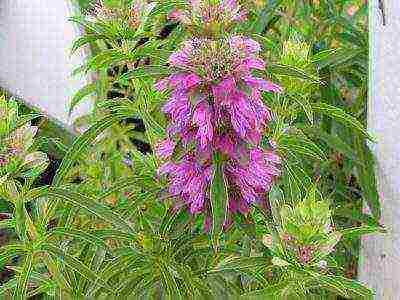
Double monard a herbaceous perennial plant that reaches a size of 0.7-1.5 m. The root is long, horizontal. The stem is tetrahedral, straight, has fine hairs. The leaves are pale green with pink veins, oblong, have large teeth. The flowers are collected in a capitate inflorescence, have a lilac or purple tint.
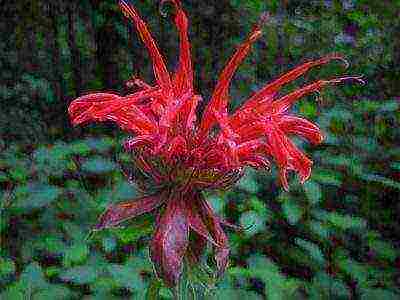
Monarda bergamot the plant belongs to the labiate family. The plant has a strong root and resistance to all diseases and pests. It is used as a seasoning for meat and salads. Also as a flavoring agent for making jams and many desserts.

Monarda hybrid this name connects all hybrids of double and tubular varieties. It is a perennial with a height of up to 100 cm. The color of flowers can be very diverse: from white to purple. Also, the size of flowers is different: from small, collected in inflorescences, to large, single. Among the varieties of this hybrid, there are a large number of sub-varieties that differ in the density of flowering, the shade of the leaves, as well as flowers.

Monarda fistus this plant is also a perennial. Belongs to the family of luciferous plants. It has a large number of branched stems, the height of which reaches 60-120 cm. The leaves have teeth. The flowers are lilac, they look like small balls, the diameter of which is about 6 cm.
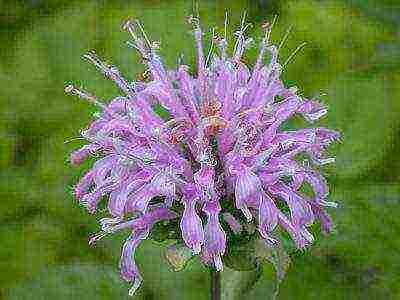
Monarda Cambridge Scarlet
The plant is a hybrid. Perennial, reaches a size of 80-100 cm. It has a long horizontal root, straight stem. The leaves are pale green, opposite each other, have short petioles. The flowers have a deep red color, collected in a capitate inflorescence. All parts of the plant have a lemon-mint tart aroma.The plant is used both for medicinal purposes and as a seasoning. The variety is resistant to cold, diseases and pests.
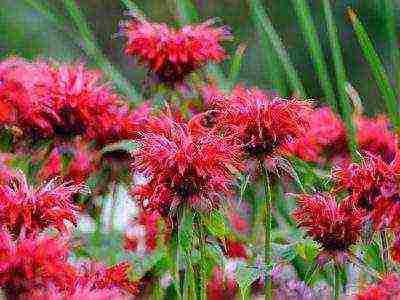
Monarda Beauty of Cobham herbaceous perennial that has unique flowers. Belongs to the labiate family. The height of the bush ranges from 700-900 cm, some specimens can reach up to 120 cm. The leaves are oblong with pointed tips. They have a green color and a pleasant aroma. On the stem, they are located opposite each other in pairs. The flowers are small, have a pleasant aroma, and are collected in capitate inflorescences.
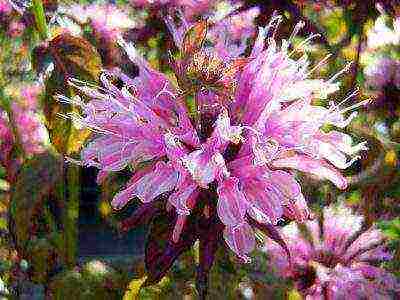
Monarda Pink Lace compact plant with pink, rather large flowers, collected in capitate inflorescences. The bush is undersized, only 40 cm tall. The plant is compact, suitable for growing in containers. All parts of the plant have a pleasant scent. Its leaves are used to make tea.
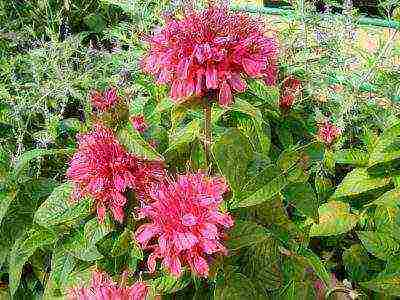
Monarda Cardinal herbaceous perennial plant. The stems are tetrahedral, the height of the bush is up to 150 cm. The flowers can be of various shades, but they are all collected in capitate inflorescences.
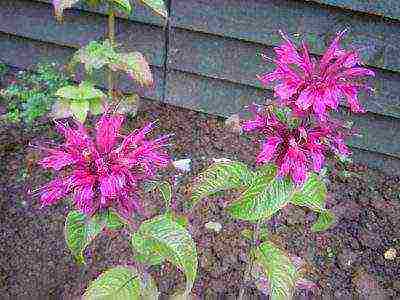
Citrodera's Monarda it is a small plant that reaches a size of 30-35 cm, has flowers collected in a dense plume. Has a pronounced bergamot aroma. Used for growing in flower beds. The leaves are used as a spice.
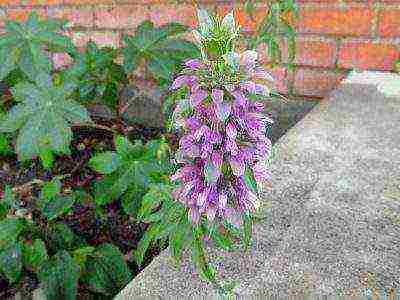
Perennial monard if you look at the plant from afar, it may seem that huge spiders with furry paws are sitting on the plant. Such a plant has flowers. All parts of the plant exude an extraordinary aroma, so they are used as a spice. Among other things, the flower looks gorgeous in bouquets.
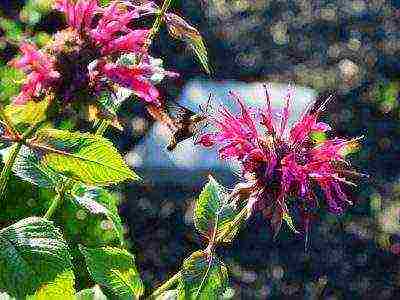
Monarda Schnewitchen
Perennial, which has a long root, the stems of the plant are tetrahedral, reaching a height of 150 cm. The flowers are white, collected in dense whorled inflorescences. They are used for group plantings in flower beds, and also looks great in bouquets.
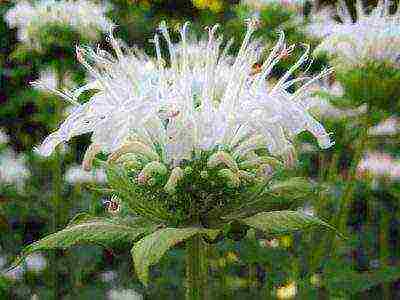
Monarda Panorama herbaceous perennial. The plant has the shape of a bush with numerous straight stems. Differs in long and abundant flowering. Large capitate inflorescences have a much disheveled appearance. The color is both pale pink and deep red. Gardeners appreciate the plant not only for its beauty, but also for its medicinal and taste qualities. It is used to make tea. On a flowerbed, it looks gorgeous in group plantings.

Monarda Gadenview Scarlet reaches a height of about 100 cm, flowers have a red tone. Used to decorate flower beds in group plantings, looks great in bouquets.
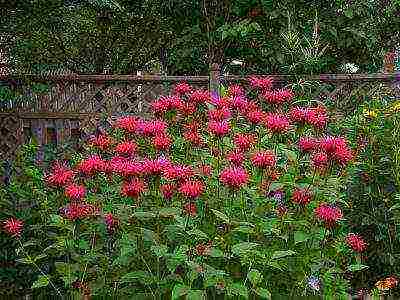
Monarda Pink Supreme the plant has the shape of a bush with a straight stem, the height of which is 70-120 cm, the stem is tetrahedral, the leaves have a pleasant smell.
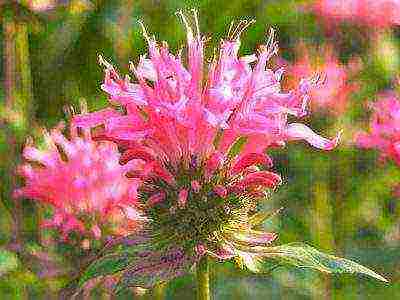
Monarda Mohawk it is a herbaceous perennial with silvery green leaves and two purple-lilac flowers. The height of the bush is about 100 cm.
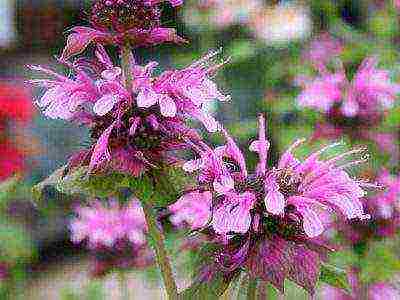
Monarda Diana herbaceous perennial plant with a pleasant lemon scent. Forms bushes up to 45 cm in diameter. Small purple flowers, collected in whorled inflorescences. Their appearance is reminiscent of candelabra. A distinctive feature of the hybrid is long and abundant flowering.
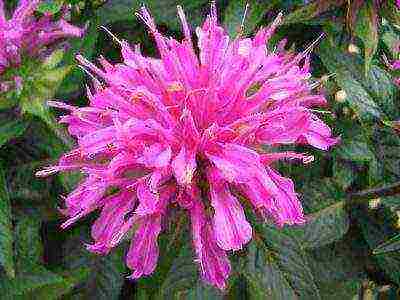
Monarda Mahagoni belongs to the family of luciferous plants. The flowers are pleasing in color and attractive in shape. The plant reaches a height of 110 cm. A distinctive feature of the hybrid is its powerful stem and small dark green leaves. The flowers are bright red and have a fairly strong aroma.

Monarda Fireball perennial rather unpretentious plant. The flowers have a dense spherical shape and an unusual wine-red hue.
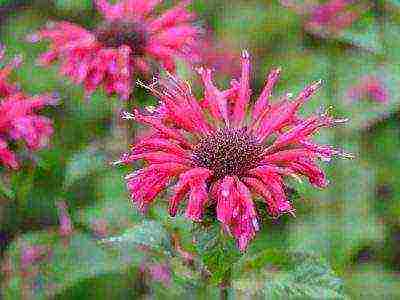
to the table of contents
Monarda planting and care in the open field
This flower grows best in the sun, but can also thrive in partial shade. True, in this case, its bushes will be lower, and flowering will be less abundant.
It is necessary to select a place for planting plants, which will be well protected from the effects of winds, since the stems can bend and bend, losing their beauty.
On hot days, the monarda should be watered moderately, in no case, avoiding waterlogging of the soil. Also, the plant does not like excessively dry soil.
To prevent the appearance of powdery mildew, it is necessary to water the plant in dry weather. If the summer is hot and dry, then it is recommended to mulch the soil with peat.
Garden bergamot is one of the varieties of monarda. It is grown during planting and care without much hassle, subject to the rules of agricultural technology. All the necessary recommendations for growing and care can be found in this article.
to the table of contents
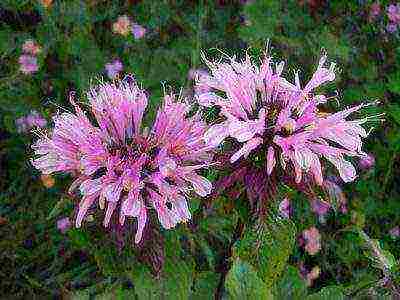
Soil for monarda
Monarda is not particularly demanding on soils, but still prefers light calcareous fertile soils. It does not feel very well on heavy, acidic and swampy soils. It can grow on poor soils, subject to constant feeding.
The soil for the future growth of the flower is prepared in the fall. The soil is dug up, weeds are removed and compost, manure or peat are applied in an amount of 2-3 kilograms per 1 m2, superphosphate - 50 grams and potassium salt - 30 grams.
If the soil is acidic, then it is necessary to additionally add 40 grams of lime for each square meter. In the spring, the soil is enriched with nitrogen fertilization. Plants are planted 60-70 centimeters between rows to provide sufficient space for nutrition and growth.
to the table of contents
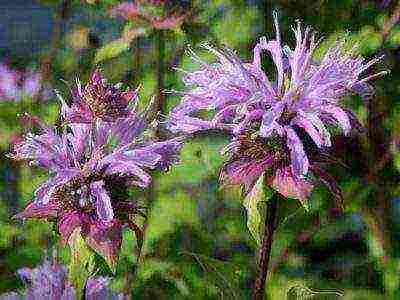
Fertilizer for monarda
Plant feeding is carried out during the period of active growth and flowering. Also, the monarda needs additional feeding during the formation of new shoots and during the transition to the dormant period.
- In the spring, the plant should be fed with a complex of mineral fertilizers. After 12 days after that, repeat the procedure.
- In the fall, the monarda is fed with potash and phosphorus compounds.
- During active growth, it is allowed to use foliar dressing. The leaves are sprayed with mineral fertilizers and microelements.
- At an excessively high air temperature, the plant is treated with Epin's solution.
to the table of contents
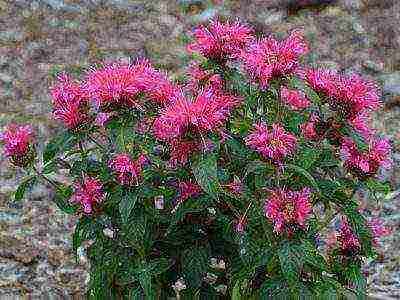
Monarda in winter
For the winter, the ground part of the plant must be completely cut off, and in the spring it will grow back.
The roots of the plant are frost-resistant and survive the winters well without additional shelter.
to the table of contents

Monarda growing from seeds
When growing monarda from seeds, they are sown in open ground in May to a depth of 1-2 centimeters. Consumption per square meter should be no more than 0.5 grams. In order to disperse the seeds more evenly, they are mixed with sand.
The germination temperature of the seeds is 20 degrees. Seedlings of monarda grow very slowly at first. It is necessary to constantly weed them, preventing weeds from drowning them out. Young plants are transplanted, first at a distance of 10 centimeters from each other, and then at 20. Grown from seeds, the monarda does not bloom in the first year.
If you wish, you can sow seeds in March to get seedlings. The ascended monards, two weeks later, dive according to the scheme of 3 × 3 centimeters. It is possible to plant in open ground only after the threat of frost has passed. The distance between plants in one row is 30 centimeters, and between rows is 60 centimeters. Be sure to water during planting.
to the table of contents

Monarda reproduction by dividing the bush
For reproduction by dividing the bush, it is necessary to pick up a healthy plant, 3-4 years old. The bush is dug up and divided in the fall.
Each of the formed parts should have 3-4 shoots and roots. Delenki are planted, like seedlings, and watered several times.
They practice reproduction of monarda and root segments, considering this method to be the most effective.
to the table of contents
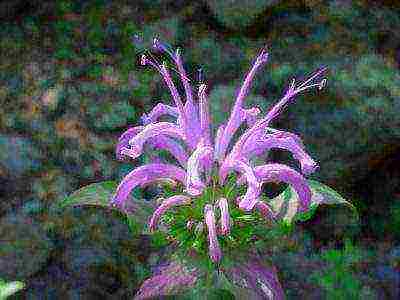
Diseases and pests
When growing in a place that is too dry or over-fertilized, the plant is affected by powdery mildew. Rust can also occur.
For treatment, drugs based on copper are used. They are suitable only in the case of growing monarda for bouquets.
If the plant is eaten, then the processing is carried out by natural means - infusions of onions, garlic or tansy. In general, the flower is quite resistant to both diseases and pests.
to the table of contents
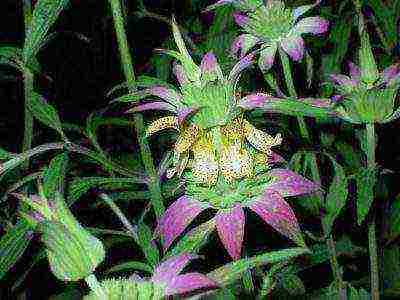
Monarda medicinal properties and contraindications
The essential oil of monarda is very valuable in medicinal terms, especially when it comes to the monarda fistus, although almost all types and varieties of this plant are successfully used by official and traditional medicine.
Almost all of its zones are endowed with healing qualities - flowers, foliage, shoots. These include strengthening the immune system, toning the central nervous system, helping to improve well-being with weakness and fatigue, relieving stress, and getting rid of depression.
At the same time, the substances that make up the oil (in particular, thymol) help the body resist aging, strengthen the strength of the capillary walls, stimulate the diuretic system, and promote the expansion of coronary vessels and lower blood pressure.
Monarda has long been used as a fragrant and healthy spice that improves digestive function. In summer and autumn, when canning takes place, its stems are placed in jars to prevent spoilage of the products they contain.
Lemon monarda is an excellent salad dressing, but for the most part it is used as a flavoring agent for tea, fruit drink or kvass in order to impart a subtle lemon-resinous aroma to drinks.
to the table of contents
